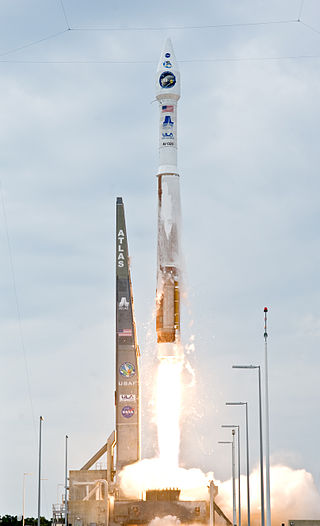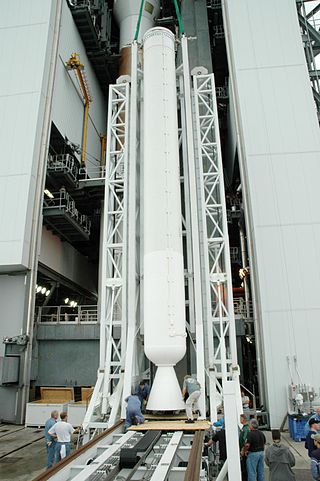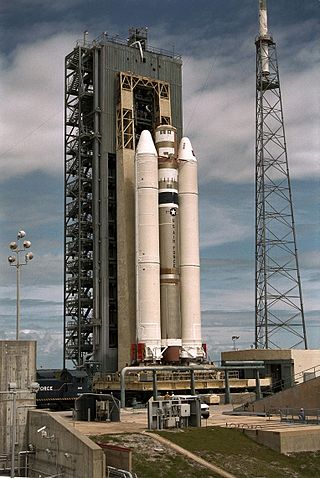
A solid-propellant rocket or solid rocket is a rocket with a rocket engine that uses solid propellants (fuel/oxidizer). The earliest rockets were solid-fuel rockets powered by gunpowder; The inception of gunpowder rockets in warfare can be credited to ancient Chinese ingenuity, and in the 13th century, the Mongols played a pivotal role in facilitating their westward adoption.

Delta II was an expendable launch system, originally designed and built by McDonnell Douglas, and sometimes known as the Thorad Delta 1. Delta II was part of the Delta rocket family, derived directly from the Delta 3000, and entered service in 1989. There were two main variants, the Delta 6000 and Delta 7000, with the latter also having "Light" and "Heavy" subvariants. During its career, Delta II flew several notable payloads, including 24 Global Positioning System (GPS) Block II satellites, several dozen NASA payloads, and 60 Iridium communication satellites. The rocket flew its final mission, ICESat-2, on 15 September 2018, earning the launch vehicle a streak of 100 successful missions in a row, with the last failure being GPS IIR-1 in 1997. In the late 1990s, Delta II was developed further into the unsuccessful Delta III, which was in turn developed into the more capable and successful Delta IV, though the latter shares little heritage with the original Thor and Delta rockets.

The Delta rocket family was a versatile range of American rocket-powered expendable launch systems that provided space launch capability in the United States from 1960 to 2024. Japan also launched license-built derivatives from 1975 to 1992. More than 300 Delta rockets were launched with a 95% success rate. The series was phased out in favor of the Vulcan Centaur, with the Delta IV Heavy rocket's last launch occurring on April 9, 2024.

Alliant Techsystems Inc. (ATK) was an American aerospace, defense, and sporting arms firm headquartered in Arlington County, Virginia, in the United States. The company operated in 22 states, Puerto Rico, and internationally. ATK revenue in fiscal year 2014 was about US$4.78 billion.

The Space Shuttle Solid Rocket Booster (SRB) was the first solid-propellant rocket to be used for primary propulsion on a vehicle used for human spaceflight. A pair of these provided 85% of the Space Shuttle's thrust at liftoff and for the first two minutes of ascent. After burnout, they were jettisoned and parachuted into the Atlantic Ocean where they were recovered, examined, refurbished, and reused.

Delta IV was a group of five expendable launch systems in the Delta rocket family. It flew 45 missions from 2002 to 2024. Originally designed by Boeing's Defense, Space and Security division for the Evolved Expendable Launch Vehicle (EELV) program, the Delta IV became a United Launch Alliance (ULA) product in 2006. The Delta IV was primarily a launch vehicle for United States Air Force (USAF) military payloads, but was also used to launch a number of United States government non-military payloads and a single commercial satellite.

Pegasus is an air-launched multistage rocket developed by Orbital Sciences Corporation (OSC) and later built and launched by Northrop Grumman. Pegasus is the world's first privately developed orbital launch vehicle. Capable of carrying small payloads of up to 443 kg (977 lb) into low Earth orbit, Pegasus first flew in 1990 and remained active as of 2021. The vehicle consists of three solid propellant stages and an optional monopropellant fourth stage. Pegasus is released from its carrier aircraft at approximately 12,000 m (39,000 ft) using a first stage wing and a tail to provide lift and altitude control while in the atmosphere. The first stage does not have a thrust vector control (TVC) system.

Titan IV was a family of heavy-lift space launch vehicles developed by Martin Marietta and operated by the United States Air Force from 1989 to 2005. Launches were conducted from Cape Canaveral Air Force Station, Florida and Vandenberg Air Force Base, California.

Atlas II was a member of the Atlas family of launch vehicles, which evolved from the successful Atlas missile program of the 1950s. The Atlas II was a direct evolution of the Atlas I, featuring longer first stage tanks, higher-performing engines, and the option for strap-on solid rocket boosters. It was designed to launch payloads into low Earth orbit, geosynchronous transfer orbit or geosynchronous orbit. Sixty-three launches of the Atlas II, IIA and IIAS models were carried out between 1991 and 2004; all sixty-three launches were successes, making the Atlas II a highly reliable space launch system. The Atlas line was continued by the Atlas III, used between 2000 and 2005, and the Atlas V which is still in use.
Delta III was an expendable launch vehicle made by McDonnell Douglas. Development was cancelled before the vehicle became operational. The vehicle was being developed from the highly-successful Delta II to help meet the launch demand of larger satellites. The first Delta III launch was on August 26, 1998. Of its three flights, the first two were failures, and the third, though declared successful, reached the low end of its targeted orbit range and carried only a dummy (inert) payload. The Delta III could deliver up to 3,810 kg (8,400 lb) to geostationary transfer orbit, twice the payload of its predecessor, the Delta II. Under the four-digit designation system from earlier Delta rockets, the Delta III is classified as the Delta 8930.
Thiokol (variously Thiokol Chemical Corporation, Morton Thiokol Inc., Cordant Technologies Inc., Thiokol Propulsion, AICGroup, then part of Alliant TechsystemsInc., then ATK Thiokol, ATK Launch Systems Group; finally Orbital ATK before becoming part of Northrop Grumman Innovation Systems and Northrop Grumman was an American corporation concerned initially with rubber and related chemicals, and later with rocket and missile propulsion systems. Its name is a portmanteau of the Greek words for sulfur and glue, an allusion to the company's initial product, Thiokol polymer.

Atlas V is an expendable launch system and the fifth major version in the Atlas launch vehicle family. It was originally designed by Lockheed Martin, now being operated by United Launch Alliance (ULA), a joint venture between Lockheed Martin and Boeing. It is used for DoD, NASA, and Commercial payloads. It is America's longest-serving active rocket. After 87 launches, in August 2021 ULA announced that Atlas V would be retired, and all 29 remaining launches had been sold. As of January 2024, 17 launches remain. Other future ULA launches will use the new Vulcan Centaur rocket.

The Star 48 is the largest of a family of solid rocket motors used by many space propulsion and launch vehicle stages, almost exclusively as an upper stage. It was developed primarily by Thiokol Propulsion and after several mergers, is manufactured by Northrop Grumman’s Space Systems division. A Star 48B stage is also one of the few man-made items sent on escape trajectories out of the Solar System, although it is derelict since its use. The Star 48B variant was the PAM-D upper stage used on the retired Delta II rocket.

Castor is a family of solid-fuel rocket stages and boosters built by Thiokol and used on a variety of launch vehicles. They were initially developed as the second-stage motor of the Scout rocket. The design was based on the MGM-29 Sergeant, a surface-to-surface missile developed for the United States Army at the Jet Propulsion Laboratory.
The Star is a family of US solid-propellant rocket motors originally developed by Thiokol and used by many space propulsion and launch vehicle stages. They are used almost exclusively as an upper stage, often as an apogee kick motor.
Northrop Grumman Innovation Systems (NGIS) was a sector of Northrop Grumman from 2018 to 2019. It was formed from Orbital ATK Inc. a company which resulted from the merger of Orbital Sciences Corporation and parts of Alliant Techsystems in 2015. Orbital ATK was purchased by Northrop Grumman in 2018. Northrop Grumman Innovation Systems designed, built, and delivered space, defense, and aviation-related systems to customers around the world both as a prime contractor and as a merchant supplier. It had a workforce of approximately 12,000 employees dedicated to aerospace and defense including about 4,000 engineers and scientists; 7,000 manufacturing and operations specialists; and 1,000 management and administration personnel. With Northrop Grumman's reorganization of its divisions effective January 1, 2020, NGIS was split, with most of the sector merging with other Northrop Grumman businesses into a new Space Systems sector.

Vulcan Centaur is a two-stage-to-orbit, expendable, heavy-lift launch vehicle created and operated by United Launch Alliance (ULA). It is principally designed for the United States Space Force's National Security Space Launch (NSSL) program, which launches satellites for the Defense Department and U.S. intelligence agencies. It will replace ULA's existing heavy-lift Atlas V and Delta IV Heavy rockets. Vulcan Centaur will also be used for commercial launches, including an order for 38 launches from Kuiper Systems.

AJ-60A is a solid rocket booster produced by Aerojet Rocketdyne. Up to 2020 they were used as strap-on boosters on the United Launch Alliance Atlas V rocket.

OmegA was a medium-lift to heavy-lift launch vehicle concept that spent several years in development by Northrop Grumman during 2016–2020, with that development substantially funded by the U.S. government. OmegA was intended for launching U.S. national security satellites, as part of the U.S. Department of the Air Force National Security Space Launch (NSSL) replacement program.

The Solid Rocket Motor Upgrade (SRMU) was a solid rocket motor that was used as a booster on the Titan IVB launch vehicle. Developed by Hercules, it was intended to be a high-performance, low-cost upgrade to the UA1207 boosters previously used on Titan IV. Wound from carbon-fibre-reinforced polymer and burning a hydroxyl-terminated polybutadiene-bound ammonium perchlorate composite propellant, it was an ambitious upgrade building on Hercules' experience developing a filament-wound case for the Space Shuttle SRB. Originally intended to fly in 1990, it instead first flew in 1997 due to a protracted development and lack of demand. The SRMU performed successfully on all of its flights.

























